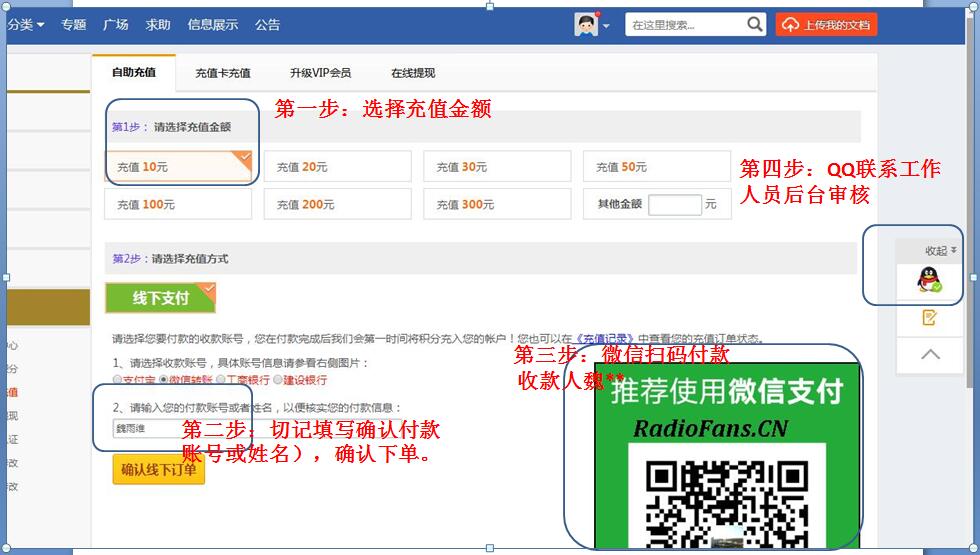 Arcam-DivaT51-tun-sm维修电路原理图.pdf
Arcam-DivaT51-tun-sm维修电路原理图.pdf
《Arcam-DivaT51-tun-sm维修电路原理图.pdf》由会员分享,可在线阅读,更多相关《Arcam-DivaT51-tun-sm维修电路原理图.pdf(15页珍藏版)》请在收音机爱好者资料库上搜索。
1、T51 DiVA T51 AM/FM Tuner Service Manual ARCAMARCAM Issue 1.0 RadioFans.CN 收音机爱 好者资料库 Contents List ! Contents list ! Circuit description ! Circuit diagrams ! Component overlays ! Circuit board parts list ! General assembly parts list RadioFans.CN 收音机爱 好者资料库 T51 Tuner Circuit Description Power Supply
2、 Mains voltage selection is made by placing a fuse, of appropriate value, in the 115V or 230V position. The single secondary is rectified and regulated and supplies four regulators. Z7 is always powered when the mains is connected and keeps the preset memory of the micro controller intact. The high-
3、value capacitor (C84) will keep this data safe, for a limited time, in case of mains power failure. Z5 provides the main 12V supply rail for the RF and audio circuits. This is always connected, except for the supply to the FM front end, which is disabled by Q2 when the unit is turned off. Z4 powers
4、the LED back light on the display PCB. Z6 is the 5V digital supply for the micro controller. FM Tuner & IF The FM aerial input is mixed in the front end FE1 which provides a 10.7MHz IF output. This is filtered and amplified by ceramic filters CF1 & CF2 and the circuit based around Q9 & Q10. A third
5、filter CF3 can be put in circuit by fitting jumpers JP1 & JP2 across pins 2 & 4 and 1 & 3 of SK6 respectively. This effectively narrows the IF band to improve selectivity. Transistors Q17 and Q21 are part of the AGC circuit. The position of the jumper link JP7 to either SK10 or SK11 determines from
6、which point the AGC circuit is triggered. The default is for the jumper to be fitted to SK10 which minimizes cross modulation and prevents the IF amp becoming saturated. The LA1266 (Z9) demodulates the IF at pin 1 into an audio output at pin 12. The quadrature coil is a double-tuned device for best
7、distortion performance. When a station is tuned correctly the On Tune signal goes low and drives a green LED on the display PCB. This signal is also used by the auto-stop detection and muting circuits. AM Tuner & IF The LA1266 (Z9) contains the AM RF amplifier, oscillator and mixer circuitry. Switch
8、ing between FM and AM modes is controlled by the FM signal from the micro controller which disables the AM circuitry of Z9 and switches the path of the audio signal through Z8. MW/LW switching is performed by switching transistors Q12, Q14 & Q15. Each band has its own oscillator and aerial tuning co
9、ils, tuned by a varicap diode all contained within the AM module L5. The 450kHz IF signal is filtered by coil and ceramic filter combination T5. Birdie Filter The Birdie Filter (L2) is a four pole low pass filter, flat to about 53kHz, then with a very steep roll off from then on. This is designed to
10、 reduce co-channel interference in FM Stereo and cut down on irritating birdie noises. Stereo Decoder Stereo decoding is performed by LA3401 (Z8). The 38kHz reference signal is accurately created by ceramic resonator X3 and does not require adjustment. Stereo separation is adjusted for maximum by pr
11、eset RV1. This IC also contains FM/AM audio switching and muting functions. Audio Filters & Output The left and right channel audio outputs from Z8 are filtered by the de-emphasis network of R1, C1 etc. The correct de-emphasis network is selected by the position of jumpers JP3 & JP4 on the pins of S
12、K8. C2 & C102 (220pF) are selected for 50us and C3 & C103 (560pF) for 75us de-emphasis. The final filter, based on Z3, is a two-pole low-pass circuit with a cut-off frequency of around 20kHz. Also included is a 19kHz notch filter, L1 & C4, that removes most of the residual pilot tone. Muting When th
13、e power switch is turned off Q5 is switched off, enabling the mute circuitry of the stereo decoder (Z8) via diode D9. This removes the need for output muting transistors and eliminates switching clicks and pops. At switch-on the mute is enabled while C21 is charged via Z8. In normal use the mute ins
14、ide Z8 is enabled in three other ways: The AMUTE signal from the micro controller is active at power-on and for a short time when a preset is changed. When the band is changed the output is muted by charging C52. The audio output must be muted whenever the tuner is in stereo mode and is also off-tun
15、e. This is to eliminate noise during tuning and is provided by Q8 and the MONO and OFF TUNE control signals. In Mono mode this mute is disabled so that weak stations can be heard, despite the noise. Micro controller Control of the DiVA T51 tuner is performed by a single micro controller Z10, LA7230.
16、 This also provides keypad input and drives a LCD directly. At power-on a matrix of diodes is scanned to set-up the controller for the correct options: D7 selects the correct frequency ranges. D10 enables the use of Auto tuning as well as manual tuning. D8 allows the Auto-tuning mode to use the IF C
17、ount method of searching. The position of jumpers JP 5 & JP6 fitted to SK9 are used to disable or enable LW and also whether the AM band steps are 9 kHz (UK) or 10 kHz (USA). Z10 provides control signal outputs for the following functions: MONO - To defeat the stereo decoder AMUTE - Turns on the mut
18、e circuit when a button is pressed & during tuning. FM, MW & LW - Only one output active low at any one time. Used to switch on specific parts of the RF circuitry as appropriate. The micro controller includes a Phase-Locked-Loop (PLL) circuit which compares the tuner local oscillator signals (FMIN &
19、 AMIN) with a reference frequency. Based on this information and the required tuned frequency the controller varies the tuning voltage to the FM and AM front ends. The tuning voltages (FMVt & AMVt) have to be filtered from the PLL by the circuitry around Q7 & Q13. Display PCB The display PCB holds t
20、he keypad, LCD display, LED back light module and On-Tune indicator. The remote control receiver consists of the receiver RX1 and the PIC micro controller, Z1, which is used to decode the incoming remote control codes from RC5 format to Sanyo type commands. This is because the Sanyo micro controller
21、, Z10, can only respond to Sanyo remote control commands. Jumper Settings Jumper Option 1 Option 2 JP1 Best sensitivity Best sound JP2 Best sensitivity Best sound JP3 De-emphasis 50uS De-emphasis 75uS JP4 De-emphasis 50uS De-emphasis 75uS JP5 LW & MW MW only JP6 AM spacing 9KHz AM spacing 10KHz JP7
22、Less X-MOD Less De-sense USA / Rest of the World If the T51 is transferred from or to the USA the following jumper settings will require changing. Jumper Rest of the World USA Action JP3 50uS 75uS De-emphasis JP4 50uS 75uS De-emphasis JP6 9KHz 10KHz AM spacing 12345678 A B C D 87654321 D C B A ISSUE
23、 DRAWING NO. DRAWING TITLE Drawn by: DATE Filename ECO No.DESCRIPTION OF CHANGE G:DATAECOECO AGENDA00_1078 L892 T51 TUNERL892_1L892_1.ddb - L892c1_1_2.prj A & R Cambridge Ltd. Pembroke Avenue Denny Industrial Centre Waterbeach Cambridge CB5 9PB T51 Tuner Circuit Diagram L892CT CL12-Sep-2000 INITIALS
24、 Date Printed 14Sheetof Notes: LK18 LK19 LK20 LK22 LK23 LK24 LK25 LK26 LK27 LK28 LK29 LK30 LK31 LK32 LK33 LK34 LK35 LK36 LK37 LK38 LK39 LK40 LK41 LK43 LK44 LK45 LK46 LK47 LK48 LK49 LK50 LK51 LK52 LK53 LK54 Tie Cable EL10 CABLE_TIE F3 T100MASP Kit Mask Exclude NF parts from kit mask, i.e. Not Fitted.
- 配套讲稿:
如PPT文件的首页显示word图标,表示该PPT已包含配套word讲稿。双击word图标可打开word文档。
- 特殊限制:
部分文档作品中含有的国旗、国徽等图片,仅作为作品整体效果示例展示,禁止商用。设计者仅对作品中独创性部分享有著作权。
- 关 键 词:
- Arcam DivaT51 tun sm 维修 电路 原理图
 收音机爱好者资料库所有资源均是用户自行上传分享,仅供网友学习交流,未经上传用户书面授权,请勿作他用。
收音机爱好者资料库所有资源均是用户自行上传分享,仅供网友学习交流,未经上传用户书面授权,请勿作他用。



 Marshall-9100-62-02-Schematic电路原理图.pdf
Marshall-9100-62-02-Schematic电路原理图.pdf


